The fast-growing kohlrabi plant is a unique cool-weather crop that is easy for beginners.
But learning how to grow kohlrabi at home starts with understanding what it needs to thrive. This detailed guide is designed to teach you just that.
Everything you need to grow kohlrabi is included here, from where and when to plant, to details on watering, sun, soil, fertilizer, temperature, pest control, harvesting tips, and much more.
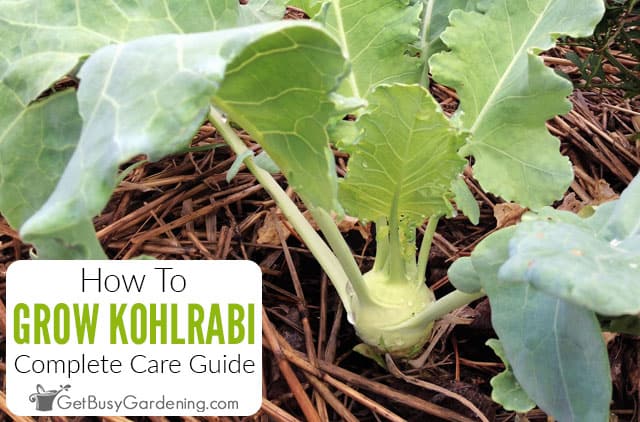
Quick Kohlrabi Plant Care Overview
| Scientific name: | Brassica oleracea |
| Classification: | Vegetable |
| Common names: | Kohlrabi, German Turnip, Cabbage Turnip |
| Hardiness: | Biennial zones 3-10 |
| Temperature: | 40-75°F (4.4-23°C) |
| Flowers: | Yellow or white, second year of growth |
| Light: | Full sun |
| Water: | Keep soil evenly moist, never allow to dry completely |
| Humidity: | Average |
| Fertilizer: | Compost or balanced liquid fertilizer, spring or fall |
| Soil: | Rich, well-draining, fertile |
| Common pests: | Cabbage loopers, cabbage worms, flea beetles |
Information About Kohlrabi
Kohlrabi (Brassica oleracea) is a biennial vegetable native to northwestern Europe, and a member of the cabbage family, along with brussels sprouts, broccoli, and cauliflower.
It produces a single above-ground swollen stem, or bulb, that can be white, purple, or green. From that grows upright, slender stems topped with blue-green leaves.
All parts of the plant are edible, and the bulbs are sweet, crisp, and juicy. The flavor is similar to a mild turnip, which is how it earned the nicknames German turnip and cabbage turnip.
They grow quickly, averaging between 45-60 days to maturity. If you leave the stem in the ground after harvesting, they can regrow to flower and set seed the following year.
Different Types Of Kohlrabi Plants
There are many varieties to choose from that range in different days to maturity, to color, and size. No matter which one you pick, they all can be cared for in the same way.
Some of the most popular varieties are:
- Early Purple Vienna – This rich purple kohlrabi is easy to grow, sweet, and ready to harvest in about 60 days.
- Early White Vienna – This small kohlrabi is white, mild, and more heat tolerant than others. Ready in about 55 days.
- Gigante – This variety is best planted in very early spring or the fall due to its long growth time of 130 days. The bulbs grow large, averaging about 10”.
- Grand Duke – This green-skinned variety is ready in 50 days. It’s popular because it can stay in the ground longer without becoming tough.
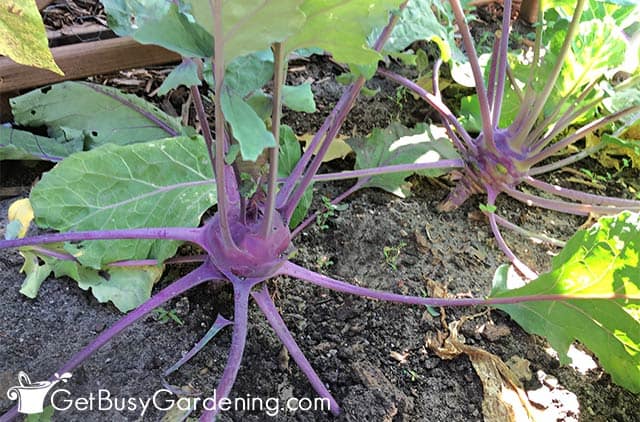
Hardiness
Kohlrabi prefers the cool weather of spring and fall. It’s a biennial in zones 3-10 and can survive lows down to 25°F (-4°C).
The bulb will become inedible in the heat of summer when it stays consistently above 75°F (23.9°C) outside.
How Does Kohlrabi Grow?
Each kohlrabi plant produces a single swollen edible stem (often called a bulb) just above the soil line that is topped with long upright blue-green leaves.
The second year the plant will produce flower stalks with yellow or white blossoms and then set seed.
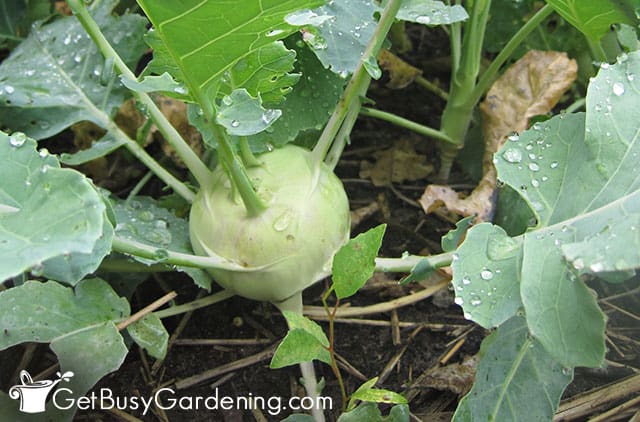
How To Grow Kohlrabi
Before we get into the details of plant care, let’s first chat about where and when to grow kohlrabi. Determining the right time and location is an important first step in a successful season.
Where To Grow Kohlrabi
Kohlrabi needs plenty of sunlight, space, and healthy soil to grow. A garden plot, raised beds, or large containers are all good options.
If you want to grow yours in a pot, be sure to choose one that’s at least 16” wide and deep with drainage holes to prevent overwatering.
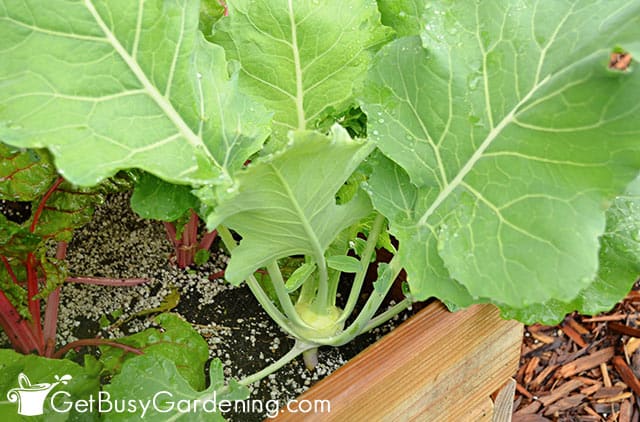
When To Plant Kohlrabi
Cool weather is key for growing kohlrabi. Plant it in the early spring, fall, or even winter in climates that don’t experience temps consistently below freezing.
Direct sow seeds as soon as the ground is workable in the spring, about 4 weeks before the last frost, or 6 weeks before the first frost of fall.
Otherwise start them indoors 2-3 weeks prior to that to get a jumpstart on the growing season.
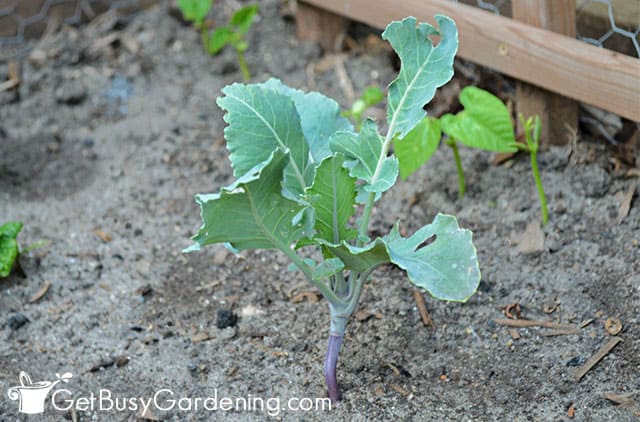
Kohlrabi Plant Care & Growing Instructions
Now that you know when and where to grow kohlrabi, it’s time to talk about how to care for it. The information in this section is key to creating the ideal environment for it to thrive.
Sunlight
Choose a full sun location for your kohlrabi. They need at least 6 hours of direct sun a day to grow well.
If they get too much shade they may grow a lot of healthy leaves, but the bulb will either be small or not form at all.
In hot, arid climates, protect the plants from the intense afternoon sun. A shade cloth works great for that.
Water
Consistent and even soil moisture is important for kohlrabi to form the round swollen stems. They should never dry completely, and need between 1-1.5” of water a week.
However it’s important to avoid overwatering to the point of making the soil soggy, which can lead to issues of rot and mold.
It’s also important to avoid periods of drought because the bulb can crack once the plant rehydrates.
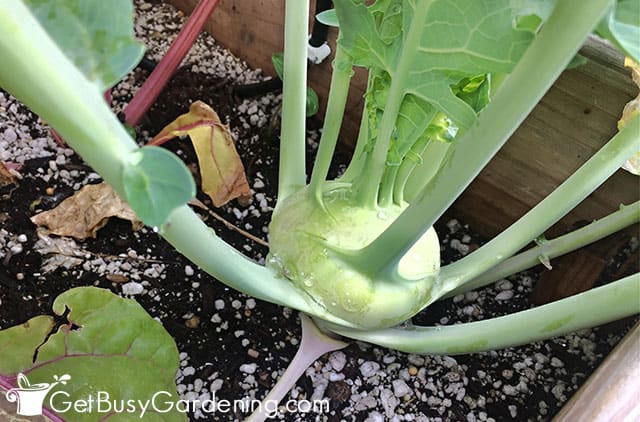
Temperature
Cool weather is also very important. It’s key for the bulb to form, and increases the sweetness. The ideal temperature range is between 40-75°F (4.4-23.9°C).
Anything below 24°F (-4.4°C) can kill it or trick the plant into thinking the season has ended, and may cause premature bolting when the weather warms again.
Temperatures above 75°F (23.9°C) will lead to tough, bitter, or misshapen bulbs.
Fertilizer
Kohlrabi is not a heavy feeder, especially when it’s growing in fertile, healthy soil. But the occasional feeding will give it a little boost.
Use a balanced, organic liquid fertilizer like compost tea or fish emulsion monthly during the growing season.
Or side-dress the plant with slow-release granules, well-rotted manure, or compost once per month until harvest.
Soil
The ideal soil for growing kohlrabi is rich and well-drained, with a pH between 6.0-6.8, which you can test with a probe meter.
Amend garden soils with compost before planting, or use a potting soil that’s rich with organic matter for containers.
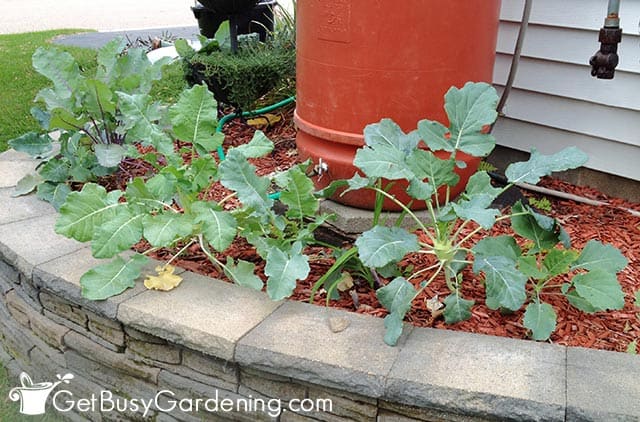
Pest Control Tips
Healthy kohlrabi doesn’t have many issues with pests, but occasionally they can be affected by flea beetles, cabbage loopers, and cabbage worms.
Hand pick large insects and drop them into a bucket of soapy water to kill them. Check the underside of leaves for eggs or cocoons and remove them immediately.
Row covers, plant collars, yellow sticky traps, and insecticidal soap can also be used to deter or get rid of pests. I make my own by mixing 1 teaspoon of gentle liquid soap with 1 liter of water.
Disease Control Tips
Diseases like clubroot, black rot, and mildew are the most common issues for kohlrabi. Wilting and yellowing leaves, or white or black spots on the foliage are signs of disease.
The best methods for managing them is to ensure each kohlrabi plant has plenty of air circulation and is in well-draining soil, and that the bed is clear of any plant debris.
Tips For Harvesting Kohlrabi
Harvesting your kohlrabi at the right time is important for the best flavor and texture. You can get all the details in my post about how to harvest kohlrabi, but here are the basics.
When the bulbs are 2-3” in diameter it’s time to harvest them, unless you’re growing a variety that’s specifically meant to be larger.
In most cases allowing them to get too big leads to a woody, tough, and bitter flavor.
The leaves are also edible. You can pick them as soon as they’re large enough. But never remove them all before the stem is ready, the plant needs them to build enough energy to form the bulb.
Use a sharp, clean pair of heavy duty pruners, and cut at the soil line beneath the swollen stem, or simply pull the whole plant because it won’t produce another bulb.
Related Post: How To Freeze Kohlrabi (With Or Without Blanching)

Troubleshooting Common Problems
Kohlrabi is fairly easy to grow, but no plant is problem free. If you run into one of these more common issues, the tips below will help you get back on track.
Woody / Tough Texture
Heat above 75°F (23.9°C), age, and inconsistent watering can all lead to a woody, tough texture.
Don’t leave kohlrabi in the ground once it’s reached the ideal size for harvesting. Keep the soil moist, without making it sodden or letting it dry out between drinks.
Use a shade cloth to shield them from the hot afternoon sun if it’s gotten too warm for them.
Kohlrabi Tall Not Round
Improperly shaped bulbs are caused by temperatures that are too hot or cold, spacing issues, inconsistent water, too much shade, or soil nutrient deficiencies.
Thin seedlings to about 9-12” apart to allow enough space, make sure they get at least 6 hours of full sun, keep the soil evenly moist, and add nutrients to it with a granular fertilizer or compost.
Leaves But No Bulb
No bulb at all is caused by overcrowding, low-quality soil, temperatures outside the ideal range, lack of sunlight, or improper watering.
Ensure the soil stays evenly moist and top-dress with fertilizer granules or compost. Give each plant 9-12” of space, and ensure they get at least 6 hours of sun per day.
Plant them as soon as your garden bed is workable in early spring, or once temps have cooled in the fall.
Kohlrabi Cracking / Splitting
Inconsistent watering is the number one reason why the bulbs crack or split open. It’s often caused by a period of drought, followed by a surplus of water.
Instead of allowing the soil to dry between drinks, apply 1-1.5” of water throughout each week so it stays consistently moist. Use a simple gauge probe to check it if you struggle with this.
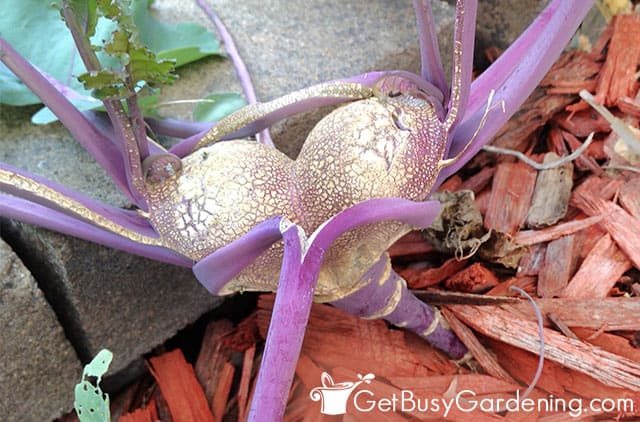
FAQs
Here I’ve answered some of the most commonly asked questions about growing kohlrabi. If yours isn’t listed, please add it to the comments section below.
Does kohlrabi come back every year?
Kohlrabi will grow back the second year if you leave the stem that’s beneath the bulb in the ground after harvesting. However as a biennial plant, it won’t grow another edible bulb. It will instead produce flowers and set seed the second year, then it won’t come back again.
Is kohlrabi easy or difficult to grow?
Kohlrabi is easy to grow once you understand the proper timing, environment, and care needs. It requires cool conditions, rich soil, consistent watering, and plenty of sunshine. High temps and dry weather can make it more difficult to grow.
How long does it take for kohlrabi to grow?
The specific amount of time it takes for kohlrabi to grow is dependent on the variety. But on average it will reach maturity sometime between 45-60 days.
How many kohlrabi do you get per plant?
You will get one kohlrabi per plant. Though they can grow back a second year, they will not yield another bulb, and instead the plant will flower and go to seed.
If you’d like to learn how to make the most of your space and get as much homegrown food as possible, then my Vertical Vegetables book is perfect! It will teach you all you need to know, has tons of gorgeous photos, and includes 23 DIY projects you can build for your own garden. Order your copy today!
Learn more about my Vertical Vegetables book here.
More About Vegetable Gardening
- How To Grow Tomatillos At Home
- How To Grow Okra
- How To Grow An Avocado Tree
- How To Grow Passion Fruit At Home
Share your tips for growing kohlrabi in the comments section below.
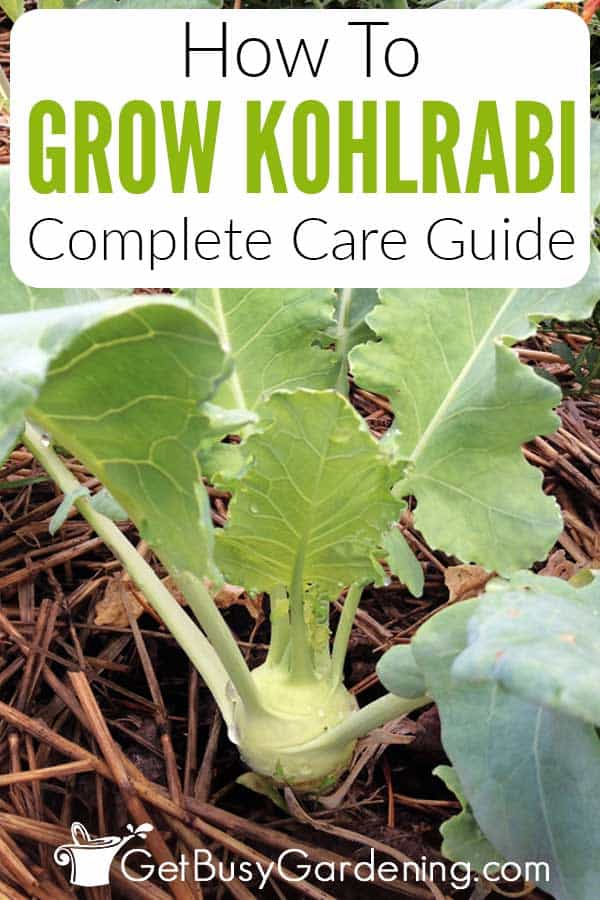
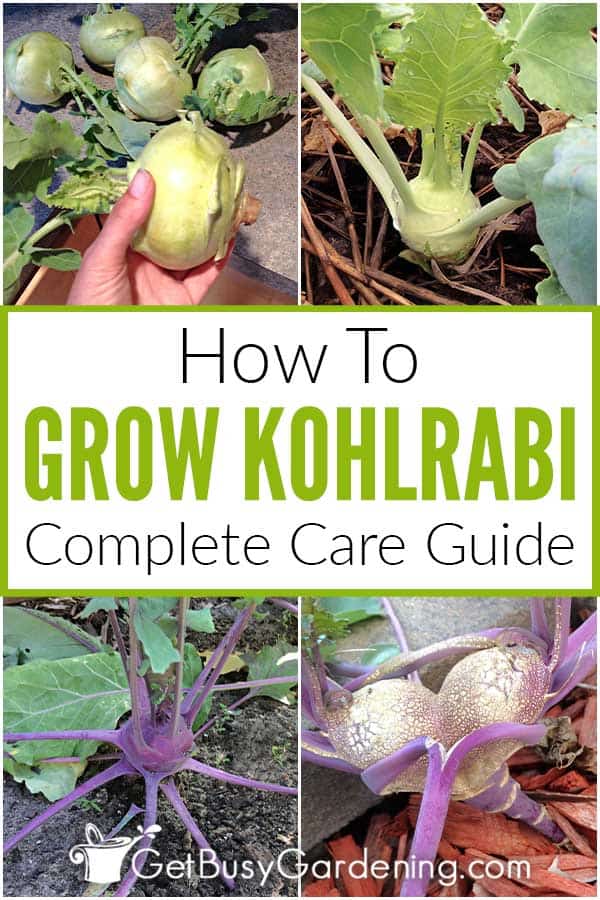
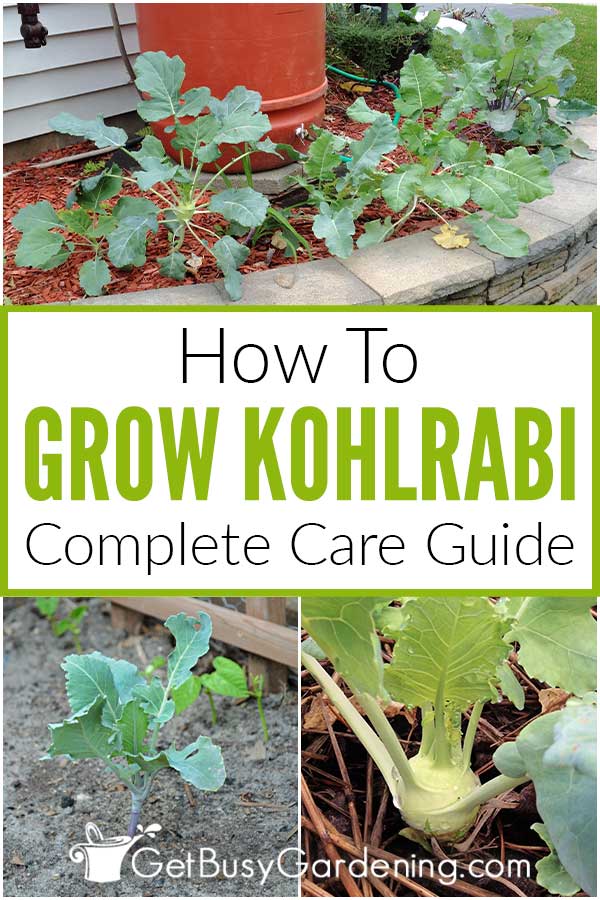


Leave a Reply